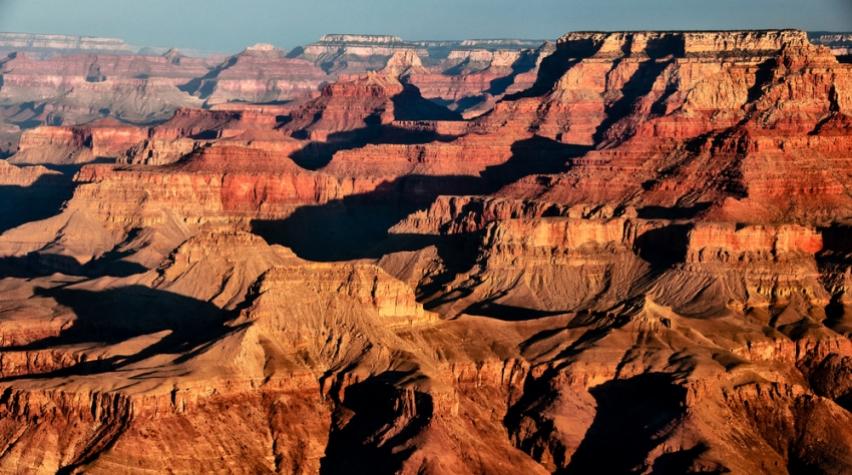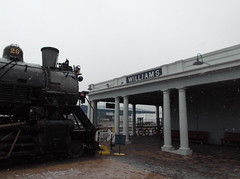
Grand Canyon Railway and Hotel
After a few days of hiking in Sedona, we headed to the really big rock formations. We spent a night at the Grand Canyon Railway Hotel in Williams, and the next morning took a train to the South Rim of the Grand Canyon National Park, where we spent a night at Maswik Lodge.
In addition to common energy- and water-saving efforts such as installing hands-free faucets and low-flow showerheads and toilets, and allowing guests to reuse linens or request fresh ones, the GCR Hotel has taken many other steps on the path to environmental sustainability. At check-in, we received a map of the property that was a laminated card labeled "Please leave this room copy for our future guests." We wondered why, if the previous guest had left it in the room, we received it from the desk clerk. I suppose it's because "for the next guest" is simpler than "so our housekeeping staff can collect it and return it to the front desk for reuse by a future guest," and as an editor I do appreciate brevity. Nevertheless, it eliminated the need for paper maps as well as the environmental impacts associated with their cradle-to-grave lifecycle. The bathroom in our room did not offer little souvenir bottles of shampoo and conditioner, which many travelers have come to rely on in order to avoid the hassle of taking these personal care products through airport security. Instead, the hotel has installed three larger, refillable pump bottles on the shower wall, dispensing shampoo, conditioner, and body wash. (Guests who want to take some home can buy a bottle in the gift shop.) The hotel collects rainwater from the roof for landscape irrigation. Solar photovoltaic panels provide power for the Grand Depot Cafe, and solar thermal panels heat water for the hotel. The GC Railway has taken numerous steps to reduce its environmental footprint. In 2009, it became the first short-line tourist railroad in the U.S. to receive ISO 14001 third-party certification of its environmental management system. Two recently converted steam locomotives now operate on waste vegetable oil collected from the hotel and cafe. Rainwater and snowmelt are harvested, and are used with reclaimed water from the wastewater treatment plant in the steam engines; this saves 11,000 gal of potable water per trip. The other locomotives burn low-sulfur diesel (15 ppm, vs. 500 ppm in the previous fuel). Locomotives no longer idle 24 hours a day to maintain engine and fuel temperatures, and instead are parked indoors, which saves 18,000 gal/yr of fuel. The Railway uses biodegradable, nontoxic pin, bearing, and journal (PB&J) oil to lubricate steam locomotive bearings, slides, and mechanical drives. On board the train, our hostess spent nearly as much time reviewing the recycling procedures (what does and does not get recycled, and which containers to put which wastes and recyclables into) as she did explaining the rules and safety procedures.
Drinking Water at the Grand Canyon
Grand Canyon National Park gets its water from Roaring Springs, which is located about 3,500 ft below the North Rim near the North Kaibab Trail. Water is piped from the springs to the South Rim via a 16-mile-long trans-canyon pipeline (TCP). The water is gravity-fed to the Indian Gardens pumping station, located 3,000 ft below the South Rim, then pumped back up from Indian Gardens to water storage tanks on the South Rim, and from there it is to the developed areas of the South Rim. Water is also pumped from Roaring Springs to North Rim water tanks by a 7-mile-long pipeline.
In the Grand Canyon -- where in July the average daily high and low temperatures are 84?F and 54?F at the South Rim and 106?F and 78?F at Phantom Ranch at the bottom, and there are few clouds in the sky to provide relief -- water can mean the difference between life and death. So some people were naturally concerned when the National Park Service (NPS) proposed banning the sale of water in individual disposable containers smaller than 1 gal (e.g., plastic bottles and various types of boxes). Instead, numerous free water stations where visitors could fill reusable bottles would be installed. The need to take some type of action to reduce plastic litter was obvious. The park had experienced increasing amounts of litter associated with disposable plastic bottles along the trails on the rims and within the inner canyon. Such waste comprised an estimated 20% of the park's overall waste stream and 30% of its recyclables; plastic bottles were one of the top two sources of litter along the rim trails. After analyzing the pros and cons, the NPS implemented the ban earlier this year. By the time we arrived (at the end of May), it appeared as if any kinks in the plan had been ironed out. Some visitors bought an inexpensive reusable bottle (priced not much more than a bottle of water would have cost) in one of the park's gift shops. Others of us continued to refill the plastic bottles we had brought into the park when we arrived. The well-equipped hikers wore hydration packs on their backs. From my vantage point, it looked like it was a resounding success. But the system was nearly put to the test. The week before (May 25), the trans-canyon pipeline broke in two places at the bottom of the canyon -- one near the South Kaibab Trail south of Phantom Ranch, and one south of the Colorado River on the Bright Angel Trail near the Pipe Creek Resthouse. Less than a week later (May 31), even before those breaks were repaired, a more-serious break occurred higher up the north side of the canyon, washing out a 45-ft section of the North Kaibab Trail between Roaring Springs and Cottonwood Campground and forcing the closure of the trail. Repairs were completed by June 6, and potable water was once again flowing to all areas of the park. During those two weeks, the entire park operation was totally dependent on water from its storage tanks. One of the park rangers told me that together the two South Rim tanks hold 8 million gal, and consumption runs about 500,000 gal/day. If the repairs had taken much longer...
Water Conservation
One of the measures the Grand Canyon National Park has implemented to stretch its water supply is publicized in the visitor center restroom. A sign above the sink explains that the water flows from a distant canyon spring, and the water-conserving faucets use less fresh water. More interesting, though, was the sign on the door of the stall -- complete with a flow diagram. The toilets use reclaimed water in a low-volume system. Fresh spring water is piped to the sinks. Gray water from the sinks, along with the sewage from the toilets, is sent to a treatment plant. Reclaimed water from the treatment plant is recycled and reused to flush the toilets.
A Corporate Culture of Sustainability
In our room in Maswik Lodge, I found a copy of' Xanterra Parks & Resorts' 2011 environmental sustainability report. Xanterra, the largest national park concessionaire in the U.S., is responsible for hospitality operations such as the lodging and dining facilities, gift shops, shuttle buses, and guided tours at the park's South Rim, which receives approximately 4.5 million visitors each year, about 5% of whom arrive by train. Xanterra also operates the Grand Canyon Railway trains and depots, as well as the hotel, cafe, and gift shops in Williams. The 48-page report provides details Xanterra's "culture of sustainability." The company's vision is to "provide quality services to visitors to our parks and resorts in the most sustainable ways possible, while maintaining profitability," and the tagline on its logo reads "Hospitality with a Softer Footprint." The report is printed on high-brightness gloss coated paper -- which might raise some eyebrows were it not for some key information on the back cover. The paper is certified by the Forest Stewardship Council (FSC) to have the following environmental benefits: o It is made with 80% recycled fiber and 60% post-consumer waste (PCW). According to its manufacturer, New Leaf Paper, most recycled coated papers in the U.S. contain only 10%-30% PCW. o It contains no elemental chlorine. o It is made with electricity that is offset with Green-e-certified renewable energy certificates. Using this paper allowed the company to save 55 fully grown trees, 25,205 gal of water, and 17 million Btu of energy, as well as avoid producing 1,530 lb of solid waste and 5,223 lb of greenhouse gases. The report is chock-full of environmental accomplishments. Here are some highlights of what the company has done: o Installed the largest renewable energy system in the tourism industry -- a 1.23-MW (DC) solar photovoltaic system that generates 2.3 million kWh/yr in Death Valley National Park. o Implemented the national park system's first complete ban on water bottle sales to eliminate disposable plastic water bottles at Zion National Park, replacing them with water stations and reusable containers. o Developed and operates the country's first train powered by waste vegetable oil, a tourist steam locomotive at the Grand Canyon that runs on used cooking grease from the Grand Canyon. o Installed a wind turbine generating 17,000 kWh/yr of clean renewable electricity at Maumee Bay State Park. o Became the first park hospitality company to receive the U.S. Green Building Council's Leadership in Energy and Environmental Design (LEED) certification. This includes a LEED Silver rating for Crater Lake National Park's Annie Creek restaurant and retail building, and LEED certification for Yellowstone National Park employee housing. o Began phasing out a fleet of diesel-fueled tour buses, replacing them with new clean-burning compressed natural gas (CNG) buses, at the Grand Canyon. The report, which you can read heret, details many more of the company's impressive achievements.
Lessons Learned
My vacation gave me a renewed respect for the earth and the environment, and it got me thinking about what I could do to make the world a better place for future generations -- and what we as chemical engineers and AIChE as an organization can do. I'll write about that next month.





Comments
Rim to River and back is an awesome hike! Thanks for sharing your experience.
Hey that was great to read. Thanks for the great post .Loved every part of it.